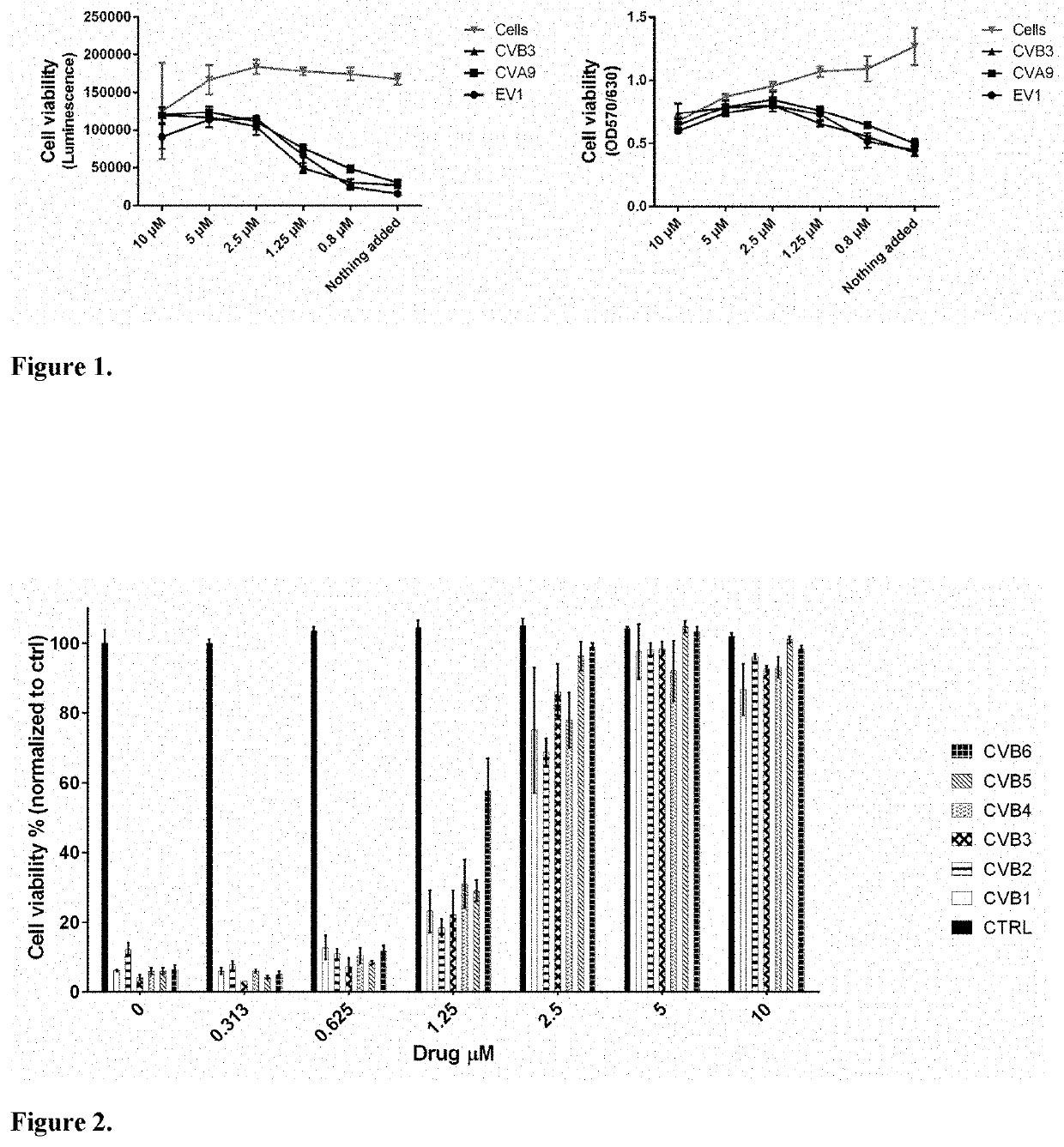Vemurafenib and salts thereof for use in the treatment of enteroviral infections
a technology of enteroviral infections and vemurafenib, which is applied in the field of medicine, can solve the problems of cancer cell proliferation, cancer cell overactive signaling, and cancer cell overgrowth and survival,
- Summary
- Abstract
- Description
- Claims
- Application Information
AI Technical Summary
Benefits of technology
Problems solved by technology
Method used
Image
Examples
example 1
[0056]Vemurafenib prevents the infection of EV1, CVA9 and CVB3 in dose dependent manner. Adenocarcinomic human alveolar basal epithelial (A549, ATCC) cells were cultured in Dulbecco's modified eagle medium (DMEM; Gibco) supplemented with 10% fetal bovine serum (FBS; Gibco), 1% Glutamax (Gibco) and 1% penicillin and streptomycin antibiotics (Gibco) for 24 h. Next day, the cells were treated for 1 h with different concentrations of vemurafenib diluted in DMEM supplemented with 1% FBS and 1% glutamax and then infected with EV1 (ATCC; Farouk strain), CVB3 (ATCC; Nancy strain) or CVA9 (ATCC; Griggs strain) and vemurafenib was present after addition of viruses. In addition, non-infected control cells were included. After 18 h post infection (p.i.), the cell viability was determined by cell titer-Glo assay according to the instructions by the manufacturer (CTG assay, which measures cellular ATP levels, Promega; left figure) or crystal violet staining as described before (right figure; Mart...
example 2
[0057]Vemurafenib prevents the infection of different CVB serotypes in dose dependent manner. A549 cells were cultured in DMEM supplemented with 10% FBS, 1% Glutamax and 1% penicillin and streptomycin antibiotics for 24 h, after which the cells were treated for 1 h with different concentrations of vemurafenib diluted in DMEM supplemented with 1% FBS and 1% glutamax. Next, the cells were infected with different CVB serotypes 1-6 (ATCC) and the infection was allowed to proceed at +37° C. for 18 h in the presence of the drug. Finally, the cell viability was determined using crystal violet staining. The results were normalized to control sample with no virus infection and 0μM concentration of vemurafenib (CTRL). The results are shown in FIG. 2. The values are means ±SD.
example 3
[0058]Vemurafenib prevents the infection of CVB4 in pancreatic beta cell line in dose dependent manner. The effect of Vemurafenib on the CVB4 E2 diabetogenic strain (provided by Ji-Won Yoon, Julia McFarlane Diabetes Research Center, Calgary, Alberta, Canada) induced CPE was studied in a mouse pancreatic beta cell line Min-6-cells (Kindly provided by A. Abderrahmani, Lille France). First, the cells were seeded in 96-well tissue culture plates (104 cells / well / 100μl) in DMEM (Gibco, Invitrogen) supplemented with 15% fetal calf serum (FCS, Sigma), 1% L-glutamine (Gibco), 50μg / ml streptomycin, and 50 IU / ml penicillin (BioWhittaker) and incubated for 24 h at 37° C., 5% CO2. The next day, Vemurafenib was added at a final concentration of 0.25, 0.5, 1, 2.5, 5 and 7.5μM and incubated for 1 h at 37° C. after which 1082 l of CVB4E2 was added to obtain an MOI of 1. The plates were incubated at 37° C. with a humidified atmosphere at 5% CO2. The viability of the cells was assessed using crystal v...
PUM
| Property | Measurement | Unit |
|---|---|---|
| weight | aaaaa | aaaaa |
| pH | aaaaa | aaaaa |
| chemical formula | aaaaa | aaaaa |
Abstract
Description
Claims
Application Information
 Login to View More
Login to View More - R&D
- Intellectual Property
- Life Sciences
- Materials
- Tech Scout
- Unparalleled Data Quality
- Higher Quality Content
- 60% Fewer Hallucinations
Browse by: Latest US Patents, China's latest patents, Technical Efficacy Thesaurus, Application Domain, Technology Topic, Popular Technical Reports.
© 2025 PatSnap. All rights reserved.Legal|Privacy policy|Modern Slavery Act Transparency Statement|Sitemap|About US| Contact US: help@patsnap.com



